Destiny 2: One Month In
It hasn’t always been easy to love Destiny. A barely comprehensible narrative – coupled with lackluster endgame content – nearly ruined any hopes the gaming community had for what Bungie launched more than three years ago amid nearly terrifying levels of hype. While the game eventually found solid footing with 2015’s The Taken King and 2016’s Rise of Iron, it could never quite undo what happened in its first year.
It’s understandable, then, that Bungie wanted to make a sequel where they could start fresh and introduce Destiny 2 to a whole new player base. At the same time, however, the game had to be able to reward the veterans – like myself – who stuck with the first game since at least 2014.
The Story – The Red War
Appeasing both newcomers and veterans meant that the only way for Bungie to create a level playing field for both kinds of Destiny 2’s players was to make everyone start from scratch. At the beginning of the campaign, all Guardians – the player characters – lose their powers and gear after the story’s main antagonist, the Cabal leader Dominus Ghaul, imprisons the Traveler and its Light for him to use. Unlike its predecessor, Destiny 2 immediately tells the player what kind of story it wants to tell – a story of loss, and a tale of reclamation. Indeed, much of the game is centered around the player regaining their powers by fighting enemies of humanity: the Cabal, the Hive, the Vex, the Fallen, and the Taken. Even better, most of the playerbase seems to know exactly what is going on in the sequel’s campaign.
If you, the reader, can honestly tell me what happened in Destiny’s original campaign without looking up the Grimoire Cards (lore stored outside the game), then you should probably get a reward. Destiny’s campaign, marred by overwhelmingly boring dialogue and equally unenthusiastic voice acting (looking at you, Dinklebot), confused players to no end, and left more questions than it did answers: Who is the Traveler? Why are we fighting aliens? Why does the Exo Stranger not have time to explain what she doesn’t have time to explain?
Obviously, ever since The Taken King, Bungie’s writers have learned from the mistakes they made in Year One. Earth’s inhabitants have never felt more imperiled, as the Cabal Red Legion’s surprise attack on humanity’s Last City cripples the Vanguard and results in the loss of every Guardian’s Light – a mystical power the Traveler gave to humanity in its dying breath, and the power that sustains Guardians.
Like its predecessor, much of the driving force behind Destiny 2’s campaign is the collective effort to save the solar system, but what really makes the sequel to Destiny different is that there is an actual villain that gives the alien invaders a face. In the previous game’s Year One, we’ve had to contend with the “Heart of Darkness” in the Black Garden and “Atheon, Time’s Conflux” in the Vault of Glass; in Year Two, we got “Oryx, the Taken King”; in Year Three, we had the SIVA nanotechnology and “Aksis, the Archon Prime.”
What makes Dominus Ghaul different from all the previously mentioned endgame antagonists is the fact that, preceding the release of the game, an origin story had already been written for Ghaul (albeit locked behind the expensive collector’s edition of the game). Unlike Oryx – whose story is chronicled in the elusive Grimoire Cards The Books of Sorrow – Ghaul’s story was more or less accessible to the playerbase, and made Dominus a more compelling character some players could try and relate to. Without hyping up the campaign, I can safely say that the inclusion of Ghaul’s character molded the narrative enough to make it interesting for players both new and old.
The World – NPCs and Content
The addition of new NPCs into the game – the “World Vendors,” as players like to call them – create atmospheres very much like the planets they are tied to. Asher Mir, the annoying Warlock vendor of Io, is just as inhospitable as the planet he resides in; Devrim Kay, a charming old Englishman, appears just as weathered and solitary as Earth’s European Dead Zone; Commander Sloane, Zavala’s Titan deputy, is both confusing and interesting – attributes she shares with her planet, the (literal) puzzle platform moon of Titan.
All these characters have their charms, but the (arguably) best one is Failsafe, the AI survivor of a shipwreck on the planetoid Nessus. Failsafe has a split-personality – she can be friendly for one second, then sarcastic and otherwise dismissive the next. Now that I think about it, it’s not hard to see similarities between Failsafe and the Portal series’ GLaDOS (if GLaDOS were less murderous and more helpful, maybe). Unlike the first game, these NPCs exist outside the social spaces Guardians return to every now and then to drop off loot freshly pried off the hands of some boss or another, and players can approach these characters in Destiny 2’s open-world.
New to the series is the inclusion of more varied open-world activities, and unlike in Destiny they provide loot that is guaranteed useful. Patrol missions – every Guardian’s best/worst friend – have been largely sidelined to make way for two new activities – Adventures and Lost Sectors – while Public Events return, now harder and more “Heroic” than ever.
Adventures are the game’s new side quests, and each one serves to contextualize the campaign and ground the Red War as an event that affects all Planets in the game. Lost Sectors, hidden areas in Planets, are areas filled with enemies that, once defeated, give you access to loot.
Public Events (my personal favorite) are no longer problems that can be solved by shooting everything in sight. Every Event has a hidden “Heroic” difficulty that can only be triggered if the players participating in the event fulfill the right conditions – destroying a boss’s support units before killing the boss itself, using the enemies’ high-powered rocket launchers against them, etc. Compared to Destiny’s tactic of leaving such mechanics in dedicated areas – like The Taken King’s popular Court of Oryx activity and Rise of Iron’s largely-ignored Archon’s Forge – Destiny 2 adds a layer of complexity to Public Events and makes them all the more interesting.
What ties all these activities neatly together is the revamped Director map feature. Whereas in the first game a player must go to orbit before accessing another activity, in the sequel they are given the freedom to begin these activities by simply fast-travelling to where these activities are in any given world, with little to no loading time. This simple addition is a huge improvement from the first game, where the general lack of an in-game map forced players to commit locations to memory or design maps of their own.
Endgame – Strikes and Raids
Finishing the campaign unlocks the rest of the game, and after that the true grind begins. At this point, players are expected to have reached a power level of 200–210, the minimum required to do Strikes – endgame content that act as both continuations of the story and pseudo-dungeons to prepare players for the Raid, arguably the hardest content to play through. Strikes in D2 are not as difficult as the first game’s, especially if teams of players do them compared to solo players. Players are expected to grind until they reach a power level of 260, the minimum requirement to access the Raid, called “Leviathan.”
Assembling a fireteam of six players was the first uphill task in completing the Leviathan Raid; at the onset, I knew only three others who played Destiny, and two of them were literally half a world away. After some convincing and a long time spent on saving, friends I had managed to invite into the world of Destiny assembled for the first time.
Completing the Raid required an intense amount of coordination and planning prior to the undertaking. Coupled with NAT Type Restrictions, slow internet connections, and the general inexperience of three of our members, myself and another teammate – the foremost veterans of the team, having played Destiny since the launch of the original, organized the remaining four to complete the only tasks their current power levels were suited to.
Our first Raid experience was an incomplete one – and to this day, we’ve yet to fully reach the final boss fight with Emperor Calus. In an MMORPG like Destiny, one might assume that not having completed the Raid means not possessing prestigious equipment usable in other activities. But with Destiny 2’s current meta, equipment matters less than the experience of playing with a team. Though our Fireteam is a young and relatively inexperienced one, going through a series of activities together with them has allowed us to better coordinate our responses to the challenges of the Raid. Soon enough, we won’t need a lot of planning when we take on Leviathan – I imagine we’ll just hop in and hope for the best.
PvP
Destiny 2’s PvP mode, called the Crucible, is now more team-centric than its previous outing. Boasting only 4v4 matches instead of the prequel’s 6v6, soloing in the mode’s maps is no longer a viable strategy. Bungie has designed the new Crucible in such a way that killing enemies will now take longer, and as such require to be taken down by groups of players through cooperative shooting of the same target. D2’s contained PvP mode now makes the experience geared towards interacting more with your teammates. The maps, now smaller compared to D1’s, had me constantly calling out radar pings to my teammates just so we had a slight tactical advantage over our enemies.
In addition to the maps being downsized, they now also allow for a wide range of combat styles. Gone are the days of solo Guardians running around a map toting overpowered shotguns, or players (most infamously Hunters) camping one spot with their No Land Beyond exotic sniper rifles. Thanks to D2’s new weapons system, sniper rifles and shotguns see limited use inside Crucible matches, and kinetic weapons (called primaries in D1) now see more action than in the previous game.
Wrap-Up
Overall, Destiny 2 is an accomplishment by itself. Having spent over three years essentially beta-testing this game, Bungie finally delivered on the promises it made back when the first game was announced in 2013. It improved, fine-tuned, and revamped almost every aspect of the “Destiny Experience.” The original may have gone through a lot of rough patches just to get to where it is today, but despite the negativity, we played and enjoyed it for hours on end. With Destiny 2, Bungie created something truly worth our time, especially if you have some friends to play it with.

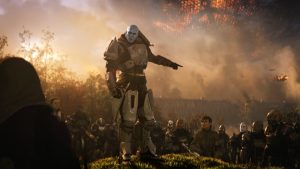
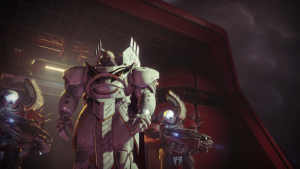
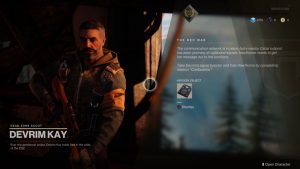
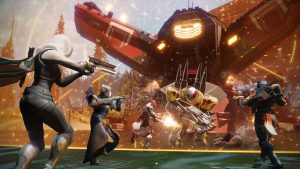
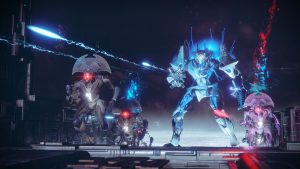
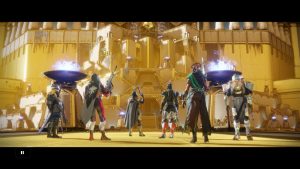
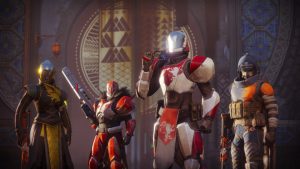
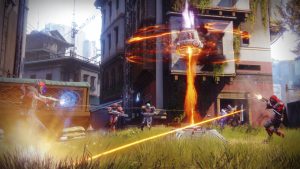
Comments